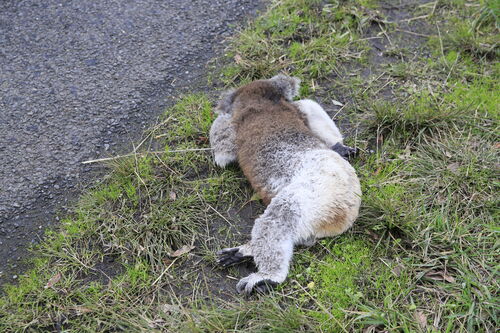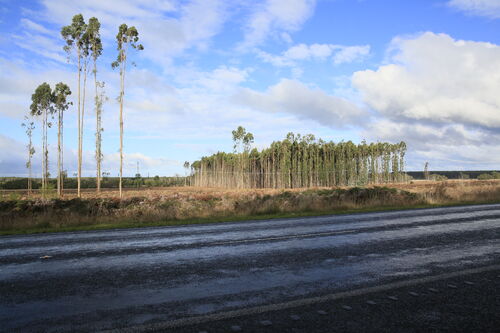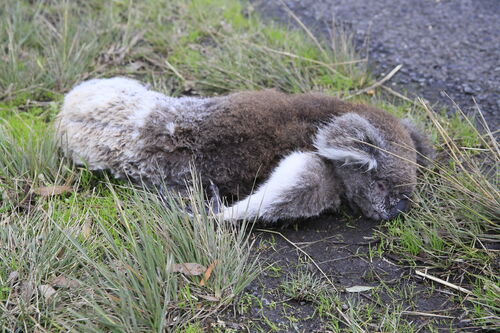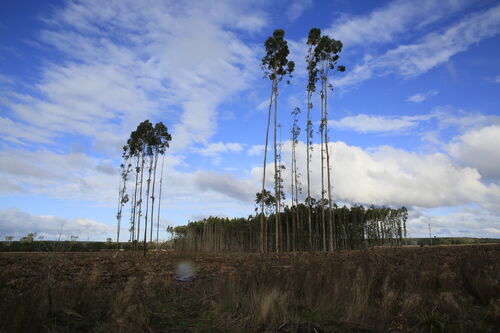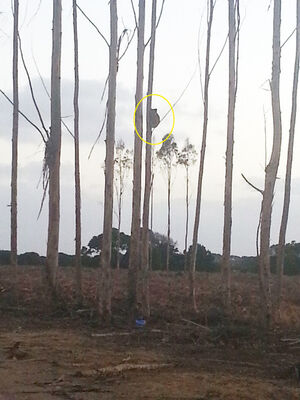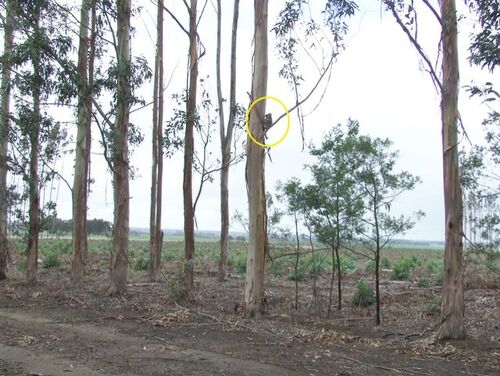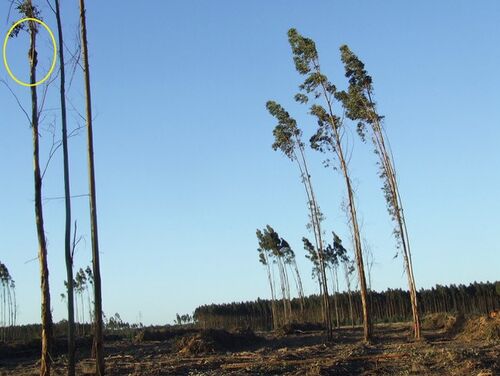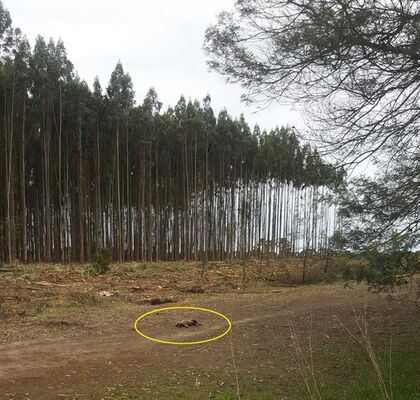Koalas in bluegum plantations
Blue Gum Plantations ~ Threats to Koala Welfare
Koalas in Blue Gum Plantations
Our furry friends have been listed as endangered in NSW, QLD and the A.C.T., but not in Victoria. Koalas listed as endangered under federal legislation have protections such as considerations and regulations during town planning and land development so this means koalas in Victoria do not have the same protections.
In the south-west of Victoria, in a region known as the “Green Triangle”, the area is home to vast plantations containing a eucalyptus species that has been planted known as the Blue Gum. These commercial plantation trees are logged and turned into wood chip for sale mainly into China and Japan to make paper products.
Only problem is koalas love Blue Gums and populate these plantations in great numbers. In 2017, the Victorian Government estimated that there were between 200,00 and 400,000 koalas living in the southwest region. As their native habitat has dwindled over the years, this means koalas have come to depend on bluegum plantations for survival and many of these plantations are now being harvested.
The government and DELWP, the state environmental government department tasked with supposedly protecting wildlife, have failed to protect koalas living in Blue Gum plantations: there is no requirement on the harvesters to relocate the koalas before logging plantations. We know that koala habitats have dwindled in the region and that DELWP "manage" Koala populations in the state and national parks to prevent overbrowsing of the manna gums.
DELWP does not actively monitor timber harvesting companies’ logging operations. This lack of scrutiny has resulted in countless and unknown koala deaths over the past two decades - it is not uncommon for koalas to be bulldozed while sitting in a tree as it’s being logged.
Our advocacy group has recently reached out to politicians with a call to action asking for their support in protection of koalas and found many were unaware and were shocked to learn of the koala welfare crisis. But many did not respond. It’s now time to hold Dan Andrews and his Ministers to account. We ask you to read our Koalas in blue gum plantations fact sheet and review our Koalas in blue gum plantations scorecard to see what political parties support our campaign to protect Victorian Koalas.
What can you do to help?
We have designed a letter template that you can download Koalas in blue gum plantations letter template and send to your local State & Federal MPs & Local Council - find your electorate & shire here: https://maps.vec.vic.gov.au/ Find the state MPs for your electorate/district here: https://new.parliament.vic.gov.au/members/member-search/
You can also send it to or call Premiere Daniel Andrews. daniel.andrews@parliament.vic.gov.au Ph:(03) 9548 5644.
We ask that you email or call and ask them why they do not support the priority actions, outlined in the Koalas in blue gum plantations scorecard. So that you understand the facts, we have researched and provided information below.
We know that Koalas are headed towards extinction, which is why WE MUST ACT NOW!
Download our quick Fact Sheet Koalas in blue gum plantations fact sheet or, scroll down for more information
Is DEWLP failing in its Duty of Care to Protect Victorian Koalas?
The welfare of koalas in blue gum plantations continues to be a major issue that is still not being properly acknowledged and addressed. The Victorian Department of Environment, Land, Water and Planning (DELWP) is responsible for the protection and conservation of wildlife in Victoria, yet an unknown number of koalas are being injured, killed, and displaced through plantation harvesting.
The Blue Gum Plantation Industry
Blue gum plantations were established through industry and government (state and federal) initiatives with tax incentives in 1997. A large commercial blue-gum plantation industry rapidly developed on farmland in south-west Victoria in an area known as the Green Triangle, centred around Hamilton and Portland. It is a premier location for growing, processing, and exporting of wood fibre to China and Japan. It is the largest wood fibre producing region in Australia 1. It is used for high quality paper. Most mills require at least some, if not all their timber input be hardwood fibre 2. It comprises approximately 130,000 hectares of blue gum plantation, with 80,000 in the distribution range of the koala, which is known as the Koala Zone. The industry operates on private land and is largely conducted by plantation management companies 3.
Habitat for Tens of Thousands of Precious Koalas
Blue gum plantations have inadvertently provided large areas of habitat for koalas to live and breed. Although it is not natural habitat, dwindling native habitat has forced koalas to take refuge in these plantations. Blue gum is a natural food source for koalas and plantations provide abundant food, shade, and shelter.
In 2020 DELWP used modelling to estimate that there were 47,000 koalas living in blue-gum plantations 4. These koalas would not exist were it not for the blue gums, but their lives matter. We have a clear obligation to treat these koalas humanely. But as the ABC 7.30 report showed in a 2013 expose, distressed logging workers and wildlife carers report daily carnage during plantation harvesting 5. This situation continues today.
Threats from Blue gum Plantation Harvesting
Thousands of hectares of blue-gum habitat are cleared each year when plantations reach maturity. There are two major welfare issues affecting koalas when blue gum plantations are felled:
Death and Injury During Harvest
In the process of harvesting plantations koalas are being killed and horrifically injured and sometimes need to be euthanised on site. 5 Because the industry is not monitored, we only hear about deaths when whistle-blowers contact the media before DELWP are notified. Machinery pulls trees from the ground and strips them of foliage in a process that can happen in minutes. Within the koala zone, koala spotters are hired to detect koalas during a harvest, but we know that spotters are failing to spot koalas due to the number of orphaned Joeys coming in to care from the blue gum plantations. Any injuries or deaths must be reported within 24 hours to DELWP, and if a dead koala is found it can be buried onsite. There is no public record of koala deaths, injuries and near misses. There is no record, nor monitoring of how many are left displaced or how many die searching for more habitat.
Displacement, Stress and Lack of Alternative Habitat
Many plantations sit within farmland with little or no surrounding habitat, so when plantations are logged, koalas are left with only scattered roadside habitat often along major roads and freeways. Wildlife carers are seeing record numbers of koalas hit by cars and trucks or being attacked by dogs and most of these koalas do not survive their injuries. The lucky ones are rescued and humanely euthanised to end their suffering. Koalas suffer major stress from losing habitat. It affects their immunity, making them sick and prone to disease. Often, by the time they reach a wildlife carer, koalas need to be humanely euthanised due to their poor health.6
Government Regulation of the Industry
Koalas are protected in Victoria under the Wildlife Act 1975 (Wildlife Act) yet timber harvesting has been causing blue gum koala deaths, injury, and displacement for decades. In 2017 the State Government was pressured by animal welfare organisations to develop a set of regulatory requirements in response to longstanding welfare impacts on blue gum koalas. But the regulations amount to industry self-regulation. The stated aim of government regulations is to minimise the impact to koalas in blue gum plantations 3. The regulations are not strong enough prevent wildlife cruelty under the Wildlife Act.
If koalas are known to be present in a plantation, the owner or manager must:
- DIY Koala Abundance Assessment which then dictates the number of koala spotters that must be employed during felling.
- Apply for an Authorisation to Disturb Koalas Permit (under section 28A (1A) of the Wildlife Act. This allows plantation companies to fell plantations where koalas are present, to move or relocate koalas and euthanise and dispose of dead koalas. Within the koala zone, the conservation regulator does not support koala relocation.
- Submit a Koala Management Plan prepared in consultation with an ecologist, detailing how they will deal with injured koalas and dispose of dead koalas.
- 9 trees must be left as a temporary buffer around each koala that is spotted during the felling process to stop them being injured by machinery. As soon as the koala moves off the tree these trees can then be felled.
- Self-report all koala deaths and injuries.
Plantation owners must apply for an Authority to Disturb Permit, issued by the Conservation Regulator (who is affiliated with DEWLP), but there is no on-ground monitoring by the regulator during the harvest and no independent oversight of plantation operators. There is no transparency as to whether a company has applied or been granted an authority to disturb koalas. Because the industry is self-regulated there is no way to verify exactly how many koalas are killed, injured, or displaced during harvesting across the whole plantation industry. The responsibility to report accurately or truthfully lies solely with plantation workers and management staff. DEWLP is failing in its due diligence by not doing routine compliance checks on plantation operators.
Further, there is no legal requirement for plantation owners to retain any habitat for koalas once the plantation – their home – has been felled, even when there is no alternative available habitat. Often there are no adjacent reserves and limited or non-existent native forest in the local area. Displacement of koalas from plantations is often in itself a death sentence but these deaths are hidden. Wildlife volunteers report that displaced koalas die from car strikes as they traverse open farmland looking for non-existent habitat if they survive those immediate threats, they then face starvation and disease or need to be euthanised due to lack of available habitat.
Why aren’t Koalas being relocated before plantation harvesting?
Habitat is increasingly fragmented and there is ongoing habitat loss. Victoria is the most land-cleared state in Australia, with considerably less than 6% left of native woodlands and forests remaining since the time of colonial settlement. 7 In Eastern Australia, nearly half of the original forested area has been lost. Clearing for pasture for livestock is a major driver of deforestation, while recent unprecedented fires are also having an impact 8. State and National parks are already home to koala populations, and some of these are being managed* for overabundance.
The ultimate responsibility for ensuring prevention of cruelty to koalas must rest with government, and not be left to private industry and individual owners where regulations are disincentives to productivity. Currently, incidents are expected to be self-reported by industry. DELWP does not physically monitor harvest operations. The only prosecutions that we are aware of have been dramatic incidents brought to light by whistle-blowers or members of the public, such as that which occurred at Cape Bridgewater (See Text Box below). This incident was not discovered by the regulator because DELWP do not conduct compliance checks. The current regulations failed these koalas.
Cape Bridgewater Animal Cruelty Offenses
Two companies and the owner of a blue gum plantation were charged by the Conservation Regulator in December 2021 with animal cruelty offenses after the alleged mass killing of koalas at a Cape Bridgewater blue gum plantation in February 2020.
They were charged with clearing habitat which wounded and caused unreasonable pain and suffering to dozens of koalas and they were also charged with destroying koalas which are a protected species
Koala Populations
According to research conducted by the Arthur Rylah Institute (ARI), a DELWP- run research facility, koalas are “abundant”, estimated to be 460,000 in all Victoria 4. This does not reflect what other studies have found. Other sources quote the total population of koalas in Victoria as being between 11,950-23,080, (Australian Koala Foundation) 9, or 200,000 just in the blue gums of south-west Victoria (DELWP/Menkorst)10, or an estimated 73,500 with 200,000 nationally (Threatened Species Commission)11. As you can see, numbers vary wildly. The truth is, no one can say with absolute certainty how many koalas there are in Victoria because these figures are only estimates.
According to the Australian Koala Foundation (AKF), Victorian koalas missed being listed as “Vulnerable” on a national level by a mere 1%.
Priority Government actions to save blue gum koalas.
BWRACs advocacy committee has contacted MPs across the state and have supplied them with our fact sheet. Koalas in blue gum plantations fact sheet We believe that the following actions must be taken by the Victorian Government urgently to prevent further suffering to koalas in blue gum plantations. See who supports these priority actions and who doesn't by downloading our political scorecard.Koalas in blue gum plantations scorecard
Priority action 1. An immediate moratorium on blue gum harvesting, until a solution is found
The Victorian government and the plantation industry have known about the koala welfare issues associated with plantations for over a decade, at least since the ABC’s 7.30 report expose in 2013. One of the main drivers was identified by carers as a lack of native habitat available for rehabilitated koalas. The government knew that koala populations were abundant in blue gums and that the voluntary guidelines were inadequate. They have adopted a “hands off” approach. Welfare issues have not been adequately addressed by government or by industry. The problem has escalated and has reached a tipping point. Many plantations are maturing and are due to be harvested which will result in an animal welfare crisis. According to the latest Victorian Koala Management Plan DRAFT, there are no government actions suggested to deal with these problems, other than looking at better technologies to detect koalas. This illustrates a complete denial or refusal to recognise other issues related to koala welfare, such as lack of habitat and deaths caused by displacement.
Priority action 2. Government Purchase of Plantations to Sustain some Habitat
The Victorian government has publicly stated that translocation is not an option due to the lack of suitable habitat for koalas in Victoria and yet they condone leaving tens of thousands of koalas ‘homeless’ when plantations are harvested. If they recognise there is no habitat and do nothing to prevent the stress, suffering and ultimately the deaths of these koalas, then they are indirectly responsible for it. To prevent further suffering, we believe that land must be either forcibly acquired or purchased to sustain as many koalas as possible.
Priority action 3. Native Habitat Restoration
Although bluegum is a primary food tree for koalas, koalas are known to be less prevalent in bluegums that have surrounding native habitat. Over the years as native habitat has been depleted on both private and public land, koalas have moved into blue gums as a means of survival. We urge the government to incentivise landowners to revegetate native trees on private land and to invest in public initiatives to restore habitats and connecting koala corridors. This needs to happen Victoria-wide as koala populations have decreased rapidly due to habitat destruction.
BWRAC collect data on Ballarat koala rescues, injuries, illnesses and outcomes. The main reason for koala deaths in the Ballarat region is from car strikes. The survival rate is approximately 15%. Koalas travel within their own territories and these territories are constantly fractured by development, major roadways and agriculture, leaving koalas vulnerable to car strikes, dog attacks and stress related illness.
Priority action 4. An Independent Wildlife Regulator to Monitor &Record Koala Deaths and Injuries
Let’s be clear. The plantation industry is a self-regulating industry that can only be prosecuted if illegal practices are reported to DEWLP by independent witnesses. This almost never happens because blue gum plantations are grown on private property with no public access. DELWP does not monitor operations. Instead, it relies on koala spotters that are hired by the plantation company to spot koalas during a harvest, and truthfully report on any koala deaths and injuries. Harvesting operations run on a schedule and like any profit making business, time is money so any detection of koalas within a plantation will affect operations. Koala spotters are also required to sign confidentiality agreements
DELWP fully understands the negative impact that this industry has on wildlife. Koalas are left displaced with no habitat, creating an ongoing welfare crisis. Wildlife carers in the region rescue koalas daily and most koalas that come into their care result in humane euthanasia. Wildlife Carers are required by law to report to DELWP on all animals in their care and on the outcomes for these animals, yet despite their reporting and pleas to help koalas, DELWP have chosen to do nothing. We believe DELWP has failed in their duty of care to protect koalas in blue gums and can no longer be trusted in their role as guardian and regulator.
Priority action 5. Mandatory Koala Proof Fencing & Partial Retainment of Blue Gums to Sustain Koalas
Currently, there are no regulations for plantation companies to fence off new plantations to prevent koala populations from moving in and breeding. New plantations should be fenced off to deter ease of access for koalas. To sustain the existing populations of koalas currently dependent on blue gums, we propose that a percentage of plantations be retained, whilst working to restore surrounding habitat for long term conservation.
Priority action 6. Independent Investigation into Koala Deaths & Impacts of Blue Gum Industry on Koalas
DELWP has failed to implement effective strategies to reduce the deaths or ongoing suffering for koalas. To date, there has been no independent monitoring or recording of koala deaths as a direct result of harvest operations and indirectly from displacement. There is no way to know how and if our precious koala populations are being protected. There is no way to know how many we have left. This lack of transparency around operational practices, permits and incident reporting suggests that DELWP supports this industry, making it difficult to ascertain if any wildlife crime is being committed under the Wildlife Act.
The welfare issues for koalas in the southwest are now at crisis point.
Tens of thousands will face displacement, suffering, and death. We call for an immediate investigation into this industry.
Potential Opportunities
Blue gum plantations play a role in the ecosystem and there are opportunities for policy development to recognise the role of plantations not only in carbon capture, but for wildlife habitat (Ashman & Watchorn, 2019). Plantations could be designed to improve movement corridors and forest habitat.
Our Position
The overall situation is grim for Victorian koalas. Anecdotally, wildlife carers know that in many places throughout Victoria koalas are simply not seen any more, where once they were abundant. The lack of monitoring of the koala population, and lack of independent, reliable peer reviewed research on koala abundance means that, outside blue gum plantations, koalas are in real danger of becoming functionally extinct* in many locations.
- We do not support the culling of koalas to manage koala populations, particularly when koala populations in Queensland, New South Wales and the Australian Capital Territory were put on the endangered list in February this year, under the Federal EPBC act.
- We support an end to the logging of native forests, and an end to habitat clearing.
- We believe that there is a place for plantations but not at the expense of our wildlife.
The grim reality for koalas living in blue gum plantations
The following video was provided by a whisteblower who was hired by a plantation company to spot koalas. We have distorted his voice to protect his privacy.
References and Links
- Green Triangle Regional Plantation Committee, 2011
- WA. Blue Gum Project, product disclosure statement to prospective growers, 2000
- Minimising impacts to koalas in blue gum plantations – Regulatory Guide, 2021
- Heard & Ramsey, 2020, Modelling Koala Abundance across Victoria, Unpublished Client Report, Arthur Rylah Institute, DELWP, p 25
- 7.30 Report Logging activities make koalas cry https://youtu.be/yvAahe-t7LQ
- Yahoo News - Victoria's koalas battling 'perfect storm of mass destruction'
Yahoo News - Fury as dozens of koalas euthanised in just one month: 'Nowhere to go'
- The Conversation - Intensive farming is eating up the Australian continent – but there’s another way
- 2021 report on Deforestation Fronts, Worldwide Fund for Nature
- Australian Koala Foundation, Imagine an Australia with no Koalas, 2022, p. 6,7, 9
- Victorian Koala Management Strategy DRAFT, DELWP, 2022, p. 27
- Threatened Species Scientific Committee, Advice to the Minister for Environment, Protection, Heritage and the Arts from the Threatened Species Scientific Committee (the Committee) on Amendment to the list of Threatened Species under the Environment Protection and Biodiversity Conservation Act 1999 (EPBC Act), September 2010, p. 21
Other useful articles:
Koala crisis in the southwest is just the beginning
Koala masacre in the southwest of Victoria
The horrible moment koala seen clinging for life on logging bulldozer
Image Source:
Image 1: Photo by J Robertson - Koala hit by car beside a recently harvested plantation
Image 2: Photo by J Robertson - An "island" of trees is left (temporarily) until the koalas have moved on.
Image 3: Photo by J Robertson - Koala found near a recently harvested plantation
Image 4: Photo by J Robertson - Regulated 9 trees left around a koala when spotted.
Image 5: Photo by JM - A koala found sweltering in the summer heat with no shade after his habitat was torn away
Image 6: Photo by JM - Another koala found left with no trees post harvesting
Image 7: Photo by JM - A koala hangs on to the tree he was left in when all other trees were harvested around him
Image 8: Photo by JM - A dead koala found outside a plantation that was being harvested
Glossary
* managed = culled
* functionally extinct - the population is reduced that it no longer plays a significant role in the ecosystem. Can also mean the population can no longer successfully reproduce in the wild to replace the population.
DONATE to support sick and injured wildlife here

